The Role of Symmetry in the Aesthetics of Residential Building Façades Using Cognitive Science Methods
Abstract
1. Introduction
2. Research Literature
2.1. Symmetry
2.2. Eye Movement
2.3. “Top-Down” and “ Bottom-Up” Processes in Aesthetic Judgment
3. Materials and Methods
3.1. Visual Stimuli
3.2. Participants
3.3. Eye Movements Task and Its Recording Device
4. Results
4.1. Study of the First Hypothesis
4.2. Study of the Second Hypothesis
5. Conclusions and Future Research
Author Contributions
Funding
Acknowledgments
Conflicts of Interest
References
- Choo, H.; Nasar, J.L.; Nikrahei, B.; Walther, D.B. Neural codes of seeing architectural styles. Sci. Rep. 2017, 7, 40201. [Google Scholar] [CrossRef]
- Jurgenhake, B. Signs and Symbols of the Domestic Façade in the City: Changes, Confusion or Decline? Presented at the ENHR 2013 Conference “Overcoming the Crisis, Integrating the Urban Environment”, Tarragona, Spain, 19–22 June 2013. [Google Scholar]
- Jack, L.N. Urban design aesthetics: The evaluative qualities of building exteriors. Environ. Behav. 1994, 26, 377–401. [Google Scholar]
- Locher, P. The usefulness of eye movement recordings to subject an aesthetic episode with visual art to empirical scrutiny. Psychol. Sci. 2006, 48, 106–114. [Google Scholar]
- Massaro, D.; Savazzi, F.; Di Dio, C.; Freedberg, D.; Gallese, V.; Gilli, G.; Marchetti, A. When art moves the eyes: A behavioral and eye-tracking study. PLoS ONE 2012, 7, e37285. [Google Scholar] [CrossRef]
- Cupchik, G.C.; Vartanian, O.; Crawley, A.; Mikulis, D.J. Viewing artworks: Contributions of cognitive control and perceptual facilitation to aesthetic experience. Brain Cogn. 2009, 70, 84–91. [Google Scholar] [CrossRef]
- Leder, H.; Belke, B.; Oeberst, A.; Augustin, D. A model of aesthetic appreciation and aesthetic judgments. Br. J. Psychol. 2004, 95, 489–508. [Google Scholar] [CrossRef]
- Locher, P.J. A measure of the information content of visual art stimuli for studies in experimental aesthetics. Empir. Stud. Arts 1995, 13, 183–191. [Google Scholar] [CrossRef]
- Locher, P.J. The contribution of eye-movement research to an understanding of the nature of pictorial balance perception: A review of the literature. Empir. Stud. Arts 1996, 14, 143–163. [Google Scholar] [CrossRef]
- Christensen, B.T.; Ball, L.J. Dimensions of creative evaluation: Distinct design and reasoning strategies for aesthetic, functional and originality judgments. Des. Stud. 2016, 45, 116–136. [Google Scholar] [CrossRef]
- Senzaki, S.; Masuda, T.; Ishii, K. When is perception top-down and when is it not? Culture, narrative, and attention. Cogn. Sci. 2014, 38, 1493–1506. [Google Scholar] [CrossRef]
- Zahedan, A.; Masoud Lavasani, M. Experience of constituting residential façade in district 17 of Tehran. MANZAR J. 2014, 6, 50–55. [Google Scholar]
- Huston, J.P.; Nadal, M.; Mora, F.; Agnati, L.F.; Conde, C.J.C. Art, Aesthetics, and the Brain; Oxford University Press: New York, NY, USA, 2015. [Google Scholar]
- Coburn, A.; Vartanian, O.; Chatterjee, A. Buildings, beauty, and the brain: A neuroscience of architectural experience. J. Cogn. Neurosci. 2017, 29, 1521–1531. [Google Scholar] [CrossRef]
- Leder, H.; Nadal, M. Ten years of a model of aesthetic appreciation and aesthetic judgments: The aesthetic episode–Developments and challenges in empirical aesthetics. Br. J. Psychol. 2014, 105, 443–464. [Google Scholar] [CrossRef]
- Vartanian, O.; Navarrete, G.; Chatterjee, A.; Fich, L.B.; Leder, H.; Modroño, C.; Skov, M. Impact of contour on aesthetic judgments and approach-avoidance decisions in architecture. Proc. Natl. Acad. Sci. USA 2013, 110 (Suppl. S2), 10446–10453. [Google Scholar] [CrossRef]
- Dupont, L.; Ooms, K.; Antrop, M.; Van Eetvelde, V. Comparing saliency maps and eye-tracking focus maps: The potential use in visual impact assessment based on landscape photographs. Landsc. Urban Plan. 2016, 148, 17–26. [Google Scholar] [CrossRef]
- Ajdari, M. Balance and Symmetry of Architectural Design-Principles of Aesthetics in Iranian Traditional Architecture. In Proceedings of the 5th International Conference on Research in Engineering, Science and Technology, Istanbul, Turkey, 14 March 2016; pp. 1–10. [Google Scholar]
- Tsai, L.Y. Math 113 Finite Math with a Special Emphasis on Math and Art; University of Miami: Miami, FL, USA, 2010. [Google Scholar]
- Hann, M. Symbol Pattern & Symmetry, The Cultural Significance of Structure; Bloomsbury: London, UK; New Delhi, India; New York, NY, USA; Sydney, Australia, 2013. [Google Scholar]
- Kojić-Prodić, B.; Štefanić, Z. Symmetry versus asymmetry in the molecules of life: Homomeric protein assemblies. Symmetry 2010, 2, 884–906. [Google Scholar] [CrossRef]
- Brandmüller, J.; Hrouda, B.; Wickede, A.V. Symmetry in Archaeology. In Symmetry: Unifying Human Understanding; Hargittai, I., Ed.; Pergamon Press Ltd.: Oxford, UK, 1986; pp. 783–787. [Google Scholar]
- Williams, K. Architecture and Mathematics: Art, Music and Science. In Bridges: Mathematical Connections in Art, Music and Science; Bridges Conference: Winfield, KS, USA, 1998; pp. 11–20. [Google Scholar]
- Salingaros, N.A. Why monotonous repetition is unsatisfying. Meand. Math. 2011. Available online: https://arxiv.org/abs/1109.1461 (accessed on 24 May 2020).
- Villarroel, J.D.; Merino, A.M. Symmetrical motifs in young children’s drawings: A study on their representations of plant life. Symmetry 2019, 11, 26. [Google Scholar] [CrossRef]
- Ramachandran, V.S.; Hirstein, W. The science of art: A neurological theory of aesthetic experience. J. Conscious. Stud. 1999, 6, 15–51. [Google Scholar]
- Dobson, J.; Gorman, L.; Moore, M.D. Consumer choice bias due to number symmetry: Evidence from real estate prices. J. Res. Consum. 2010, 17, 1–12. [Google Scholar]
- Wagemans, J. Detection of Visual Symmetries. Spec. Vis. 1995, 9, 9–32. [Google Scholar] [CrossRef]
- Grammer, K.; Thornhill, R. Human Facial Attractiveness and Sexual Selection: The Role of Symmetry and Averageness. J. Comp. Psychol. 1994, 108, 233–242. [Google Scholar] [CrossRef]
- Persian Tourism. Available online: http://www.persiantourismguide.com/2015/08/29/borujerdis-house/#prettyPhoto (accessed on 18 June 2020).
- Wikipedia, the Free Encyclopedia. Available online: https://en.wikipedia.org/wiki/Facial_symmetry (accessed on 3 August 2020).
- Rosa, M.; Orey, D. Symmetrical Freedom Quilts: The Ethno mathematics of Ways of Communication Liberation and Art. Rev. Lat. Am. de Etnomatemática 2009, 2, 52–75. [Google Scholar]
- Zaidel, D.W.; Cohen, J.A. The face, beauty, and symmetry: Perceiving asymmetry in beautiful faces. Int. J. Neurosci. 2005, 115, 1165–1173. [Google Scholar] [CrossRef]
- Zaidel, D.W.; Hessamian, M. Asymmetry and symmetry in the beauty of human faces. Symmetry 2010, 2, 136–149. [Google Scholar] [CrossRef]
- Chatterjee, A. The Aesthetic Brain: How We Evolved to Desire Beauty and Enjoy Art; Oxford University Press: New York, NY, USA, 2014. [Google Scholar]
- Ruggles, D.H. Beauty, Neuroscience, and Architecture: Timeless Patterns and Their Impact on Our Well-Being; Fibonacci: LLC, Kentucky, 2018. [Google Scholar]
- Leder, H.; Tinio, P.P.; Brieber, D.; Kröner, T.; Jacobsen, T.; Rosenberg, R. Symmetry Is Not a Universal Law of Beauty. Empir. Stud. Arts 2019, 37, 104–114. [Google Scholar] [CrossRef]
- Weichselbaum, H.; Leder, H.; Ansorge, U. Implicit and Explicit Evaluation of Visual Symmetry as a Function of Art Expertise. i-Perception 2018, 9, 2041669518761464. [Google Scholar] [CrossRef]
- Henderson, J.M. Regarding scenes. Curr. Dir. Psychol. Sci. 2007, 16, 219–222. [Google Scholar] [CrossRef]
- Castelhano, M.S.; Henderson, J.M. Initial scene representations facilitate eye movement guidance in visual search. J. Exp. Psychol. Hum. Percept. Perform. 2007, 33, 753–763. [Google Scholar] [CrossRef]
- Schraa-Tam, C.K.; van Broekhoven, P.; van der Geest, J.N.; Frens, M.A.; Smits, M.; van der Lugt, A. Cortical and cerebellar activation induced by reflexive and voluntary saccades. Exp. Brain Res. 2009, 192, 175–187. [Google Scholar] [CrossRef]
- Castelhano, M.S.; Mack, M.L.; Henderson, J.M. Viewing task influences eye movement control during active scene perception. J. Vis. 2009, 9, 6. [Google Scholar] [CrossRef]
- Filin, A.V. Avtomatya Saccad [Automatism of Saccades]; Moscow State University: Moscow, Russia, 2002. [Google Scholar]
- Zvyagina, N.; Sokolova, L.; Morozova, L.; Lukina, S.; Cherkasova, A. Eye Tracking and Autonomic Nervous System Reactivity During Perception of Visual Environments of Different Comfort. Eur. Sci. J. 2014, 10. [Google Scholar] [CrossRef]
- Netek, R. Implementation of Ria concept and Eye tracking system for cultural heritage. Opgeroepen op Sept. 2011, 9, 2012–2019. [Google Scholar]
- Klingner, J.M. Measuring Cognitive Load during Visual Tasks by Combining Pupillometry and Eye Tracking. Ph.D. Thesis, Stanford University, Stanford, CA, USA, 2010. [Google Scholar]
- Ebert, A.; Veer, G.; Domik, G.; Gershon, N.; Scheler, I. Building Bridges: HCI, Visualization, and Non-Formal Modeling; Springer: Berlin/Heidelberg, Germany, 2013. [Google Scholar]
- Jowers, I.; Prats, M.; McKay, A.; Garner, S. Evaluating an eye tracking interface for a two-dimensional sketch editor. Comput.-Aided Des. 2013, 45, 923–936. [Google Scholar] [CrossRef]
- Karatekin, C. Eye tracking studies of normative and atypical development. Dev. Rev. 2007, 27, 283–348. [Google Scholar] [CrossRef]
- Holmqvist, K.; Nystrm, M.; Andersson, R.; Dewhurst, R.; Jarodzka, H.; Van de Weijer, J. Eye Tracking: A Comprehensive Guide to Methods and Measures; Oxford University Press: New York, NY, USA, 2011. [Google Scholar]
- Gegenfurtner, A.; Lehtinen, E.; Säljö, R. Expertise differences in the comprehension of visualizations: A meta-analysis of eye-tracking research in professional domains. Educ. Psychol. Rev. 2011, 23, 523–552. [Google Scholar] [CrossRef]
- Zangemeister, W.H.; Sherman, K.; Stark, L. Evidence for a global scan path strategy in viewing abstract compared with realistic images. Neuropsychologia 1995, 33, 1009–1025. [Google Scholar] [CrossRef]
- Kim, M.; Kang, Y.; Bakar, S.A. A Nightscape Preference Study Using Eye Movement Analysis. ALAM CIPTA Int. J. Sustain. Trop. Des. Res. Pract. 2013, 6, 85–99. [Google Scholar]
- Seideman, J.A.; Stanford, T.R.; Salinas, E. Saccade metrics reflect decision-making dynamics during urgent choices. Nat. Commun. 2018, 9, 2907. [Google Scholar] [CrossRef]
- Locher, P.J. Contemporary experimental aesthetics: Procedures and findings. Handb. Econ. Art Cult. 2014, 2, 49–80. [Google Scholar]
- Holzinger, A. Biomedical Informatics: Discovering Knowledge in Big Data; Springer: Berlin/Heidelberg, Germany, 2014. [Google Scholar]
- Gifford, R.; Hine, D.W.; Muller-Clemm, W.; Reynolds, D.J., Jr.; Shaw, K.T. Decoding modern architecture: A lens model approach for understanding the aesthetic differences of architects and laypersons. Environ. Behav. 2000, 32, 163–187. [Google Scholar] [CrossRef]
- Gifford, R.; Hine, D.W.; Muller-Clemm, W.; Shaw, K.T. Why architects and laypersons judge buildings differently: Cognitive properties and physical bases. J. Archit. Plan. Res. 2002, 19, 131–148. [Google Scholar]
- Ilbeigi, M.; Ghomeishi, M. An assessment of Aesthetics in Conceptual Properties and its Relation to Complexity among Architects and Non-Architects in Residential Façade Design in Iran. J. Build. Sustain. 2017, 2, 1. [Google Scholar]
- Ruta, N.; Mastandrea, S.; Penacchio, O.; Lamaddalena, S.; Bove, G. A comparison between preference judgments of curvature and sharpness in architectural façades. Archit. Sci. Rev. 2019, 62, 171–181. [Google Scholar] [CrossRef]
- Shemesh, A.; Talmon, R.; Karp, O.; Amir, I.; Bar, M.; Grobman, Y.J. Affective response to architecture–investigating human reaction to spaces with different geometry. Archit. Sci. Rev. 2017, 60, 116–125. [Google Scholar] [CrossRef]
- Keul, A.G.; Hutzler, F.; Frauscher, G.; Voigt, A. Architrack: Evaluating architectural preferences via eyetracker. In Designing Social Innovation: Planning, Building, Evaluating; Martens, B., Keu, A.G., Eds.; Hogrefe Publishing: Boston, MA, USA, 2005; pp. 55–63. [Google Scholar]
- Yousefi, M.V.; Karan, E.; Mohammadpour, A.; Asadi, S. Implementing eye tracking technology in the construction process. In Proceedings of the 51st ASC Annual International Conference Proceedings, College Station, TX, USA, 22–25 April 2015. [Google Scholar]
- Cho, H. A Study on the Comparison of the Visual Attention Characteristics on the Façade Image of a Detached House Due to the Features on Windows. J. Asian Archit. Build. Eng. 2016, 15, 209–214. [Google Scholar] [CrossRef]
- Sussman, A.; Ward, J. Eye-tracking boston city hall to better understand human perception and the architectural experience. New Des. Ideas 2019, 3, 53–59. [Google Scholar]
- Meso, A.I.; Montagnini, A.; Bell, J.; Masson, G.S. Looking for symmetry: Fixational eye movements are biased by image mirror symmetry. J. Neurophysiol. 2016, 116, 1250–1260. [Google Scholar] [CrossRef]
- Makin, A.D.J.; Poliakoff, E.; Rampone, G.; Bertamini, M. Spontaneous ocular scanning of visual symmetry is similar during classification and evaluation tasks. i-Perception 2020. [Google Scholar] [CrossRef]
- Leder, H.; Gerger, G.; Brieber, D. Aesthetic Appreciation: Convergence from Experimental Aesthetics and Physiology. In Art, Aesthetics and the Brain; Huston, J.P., Nadal, M., Mora, F., Agnati, L.F., Cela-Conde, C.J., Eds.; Oxford University Press: New York, NY, USA, 2015; pp. 57–78. [Google Scholar]
- Berman, M.G.; Hout, M.C.; Kardan, O.; Hunter, M.R.; Yourganov, G.; Henderson, J.M.; Jonides, J. The perception of naturalness correlates with low-level visual features of environmental scenes. PLoS ONE 2014, 9, e114572. [Google Scholar] [CrossRef]
- Santos, R. Cronbach’s Alpha: A Tool for Assessing the Reliability of Scales. J. Ext. 1999, 37, 9–35. [Google Scholar]
- Tang, J.; Long, Y. Measuring visual quality of street space and its temporal variation: Methodology and its application in the Hutong area in Beijing. Landsc. Urban Plan. 2019, 191, 103436. [Google Scholar] [CrossRef]
- Mirzaei, J.; Ahmadi, S.; Lorestani, A. Spatial Analysis of Prosperity Levels in Tehran Metropolis from the Perspective of Urban Economics. IUESA 2015, 3, 59–77. [Google Scholar]
- Olszewska, A.A.; Marques, P.F.; Ryan, R.L.; Barbosa, F. What makes a landscape contemplative? Environ. Plan. B Urban Anal. City Sci. 2018, 45, 7–25. [Google Scholar] [CrossRef]
- Brunye, T.T.; Carney, P.A.; Allison, K.H.; Shapiro, L.G.; Weaver, D.L.; Elmore, J.G. Eye movements as an index of pathologist visual expertise: A pilot study. PLoS ONE 2014, 9, e103447. [Google Scholar] [CrossRef]
- Tinio, P.P.; Gerger, G.; Leder, H. Birds of a feather. Generalization of facial structures following massive familiarization. Acta Psychol. 2013, 144, 463–471. [Google Scholar] [CrossRef]
- Rhodes, G. The evolutionary psychology of facial beauty. Annu. Rev. Psychol. 2006, 57, 199–226. [Google Scholar] [CrossRef]
- Lindell, A.K.; Mueller, J. Can science account for taste? Psychological insights into art appreciation. J. Cogn. Psychol. 2011, 23, 453–475. [Google Scholar] [CrossRef]
- Shaweesh, A.I.M.; Clement, J.G.; Thomas, C.D.L.; Bankier, A. Construction and use of facial archetypes in anthropology and syndrome diagnosis. Forensic Sci. Int. 2006, 159, S175–S185. [Google Scholar] [CrossRef]
- Salingaros, N.; Masden, K. Neuroscience, the natural environment, and building design. In Biophilic Design: The Theory, Science and Practice of Bringing Buildings to Life; Wiley: Toronto, ON, Canada, 2008. [Google Scholar]
- Salingaros, N.A. Why we need to “grasp” our surroundings: Object affordance and prehension in architecture. J. Archit. Urban. 2017, 41, 163–169. [Google Scholar] [CrossRef]
- Hollander, J.B.; Sussman, A. Cognitive Architecture; Routledge: New York, NY, USA, 2015. [Google Scholar]
- Eberhard, J.P. Brain Landscape the Coexistence of Neuroscience and Architecture; Oxford University Press: New York, NY, USA, 2009. [Google Scholar]
- Salingaros, N.A. Socio-cultural identity in the age of globalization. New Des. Ideas 2018, 2, 5–19. [Google Scholar]
- Hasse, C.; Weber, R. Eye movements on façades: The subjective perception of balance in architecture and its link to aesthetic judgment. Empir. Stud. Arts 2012, 30, 7–22. [Google Scholar] [CrossRef]
- Gartus, A.; Völker, M.; Leder, H. What Experts Appreciate in Patterns: Art Expertise Modulates Preference for Asymmetric and Face-Like Patterns. Symmetry 2020, 12, 707. [Google Scholar] [CrossRef]
- Reber, R.; Wurtz, P.; Zimmermann, T.D. Exploring ‘‘fringe’’ consciousness: The subjective experience of perceptual fluency and its objective bases. Conscious. Cogn. 2003, 13, 47–60. [Google Scholar] [CrossRef]
- Reber, R.; Schwartz, N.; Winkelman, P. Processing fluency and aesthetic pleasure: Is beauty in the perceiver’s processing experience? Personal. Soc. Psychol. Rev. 2004, 8, 364–382. [Google Scholar] [CrossRef]
- Barlow, H.B.; Reeves, B.C. The versatility and absolute efficiency of detecting mirror symmetry in random dot displays. Vis. Res. 1979, 19, 783–793. [Google Scholar] [CrossRef]
- Makin, A.D.; Bertamini, M.; Jones, A.; Holmes, T.; Zanker, J.M. A gaze-driven evolutionary algorithm to study aesthetic evaluation of visual symmetry. i-Perception 2016, 7, 2041669516637432. [Google Scholar] [CrossRef]
- Makin, A.D.J.; Pecchinenda, A.; Bertamini, M. Implicit affective evaluation of visual symmetry. Emotion 2012, 12, 1021–1030. [Google Scholar] [CrossRef]


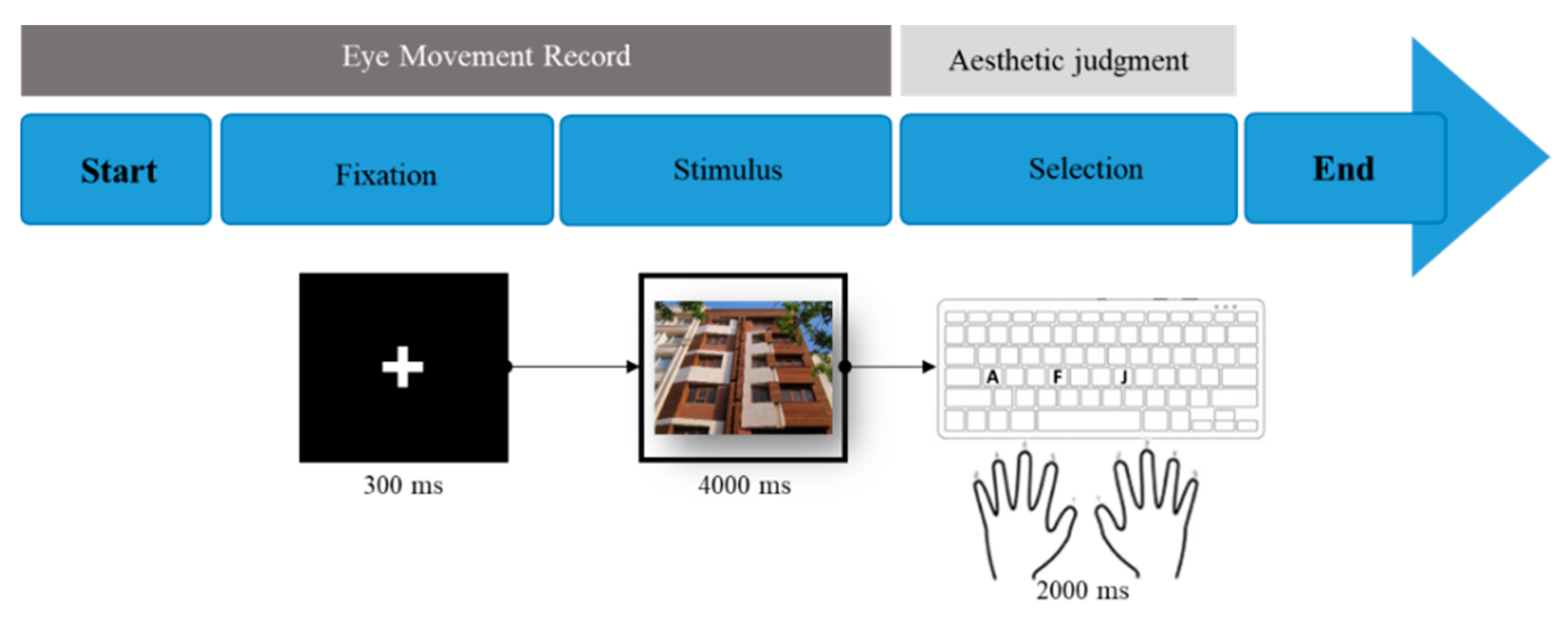
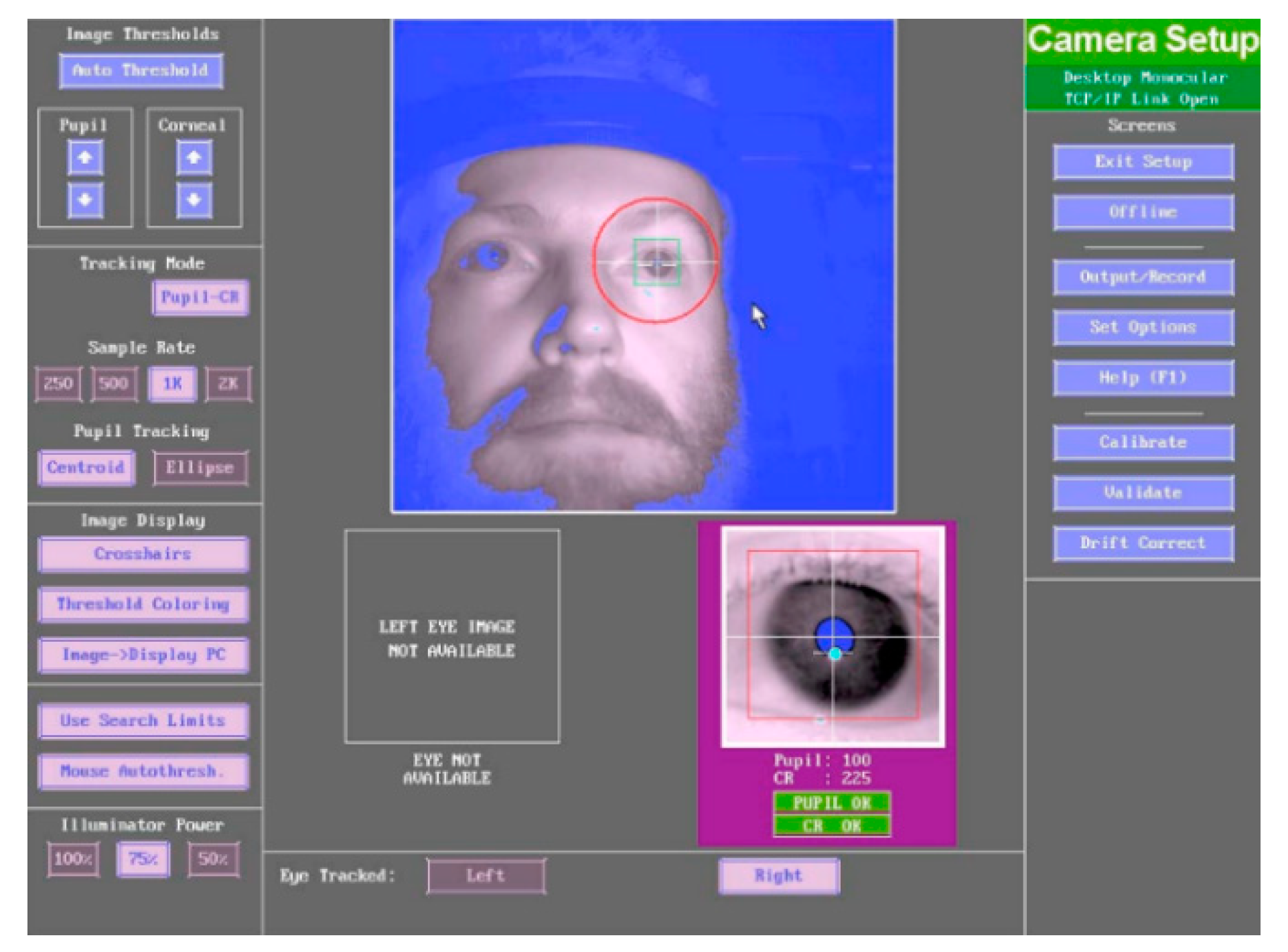
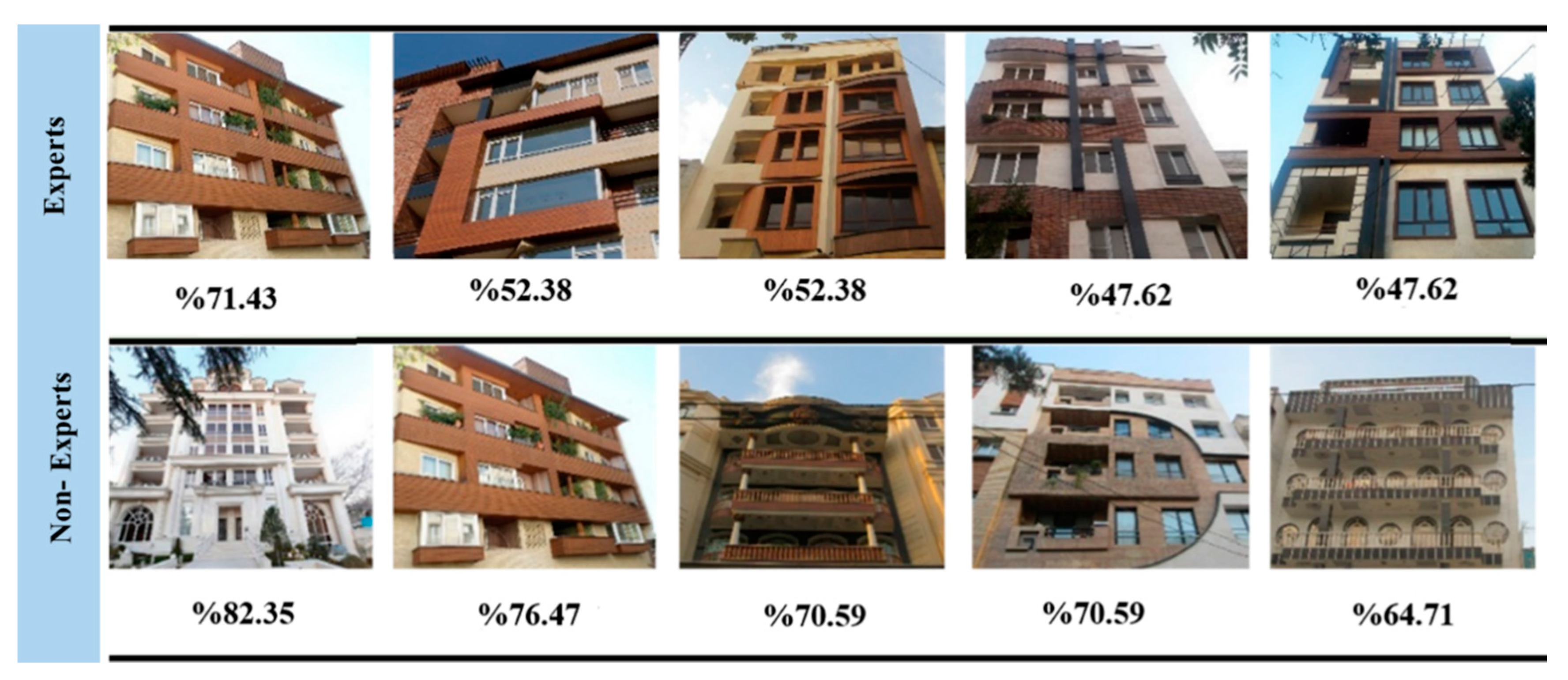
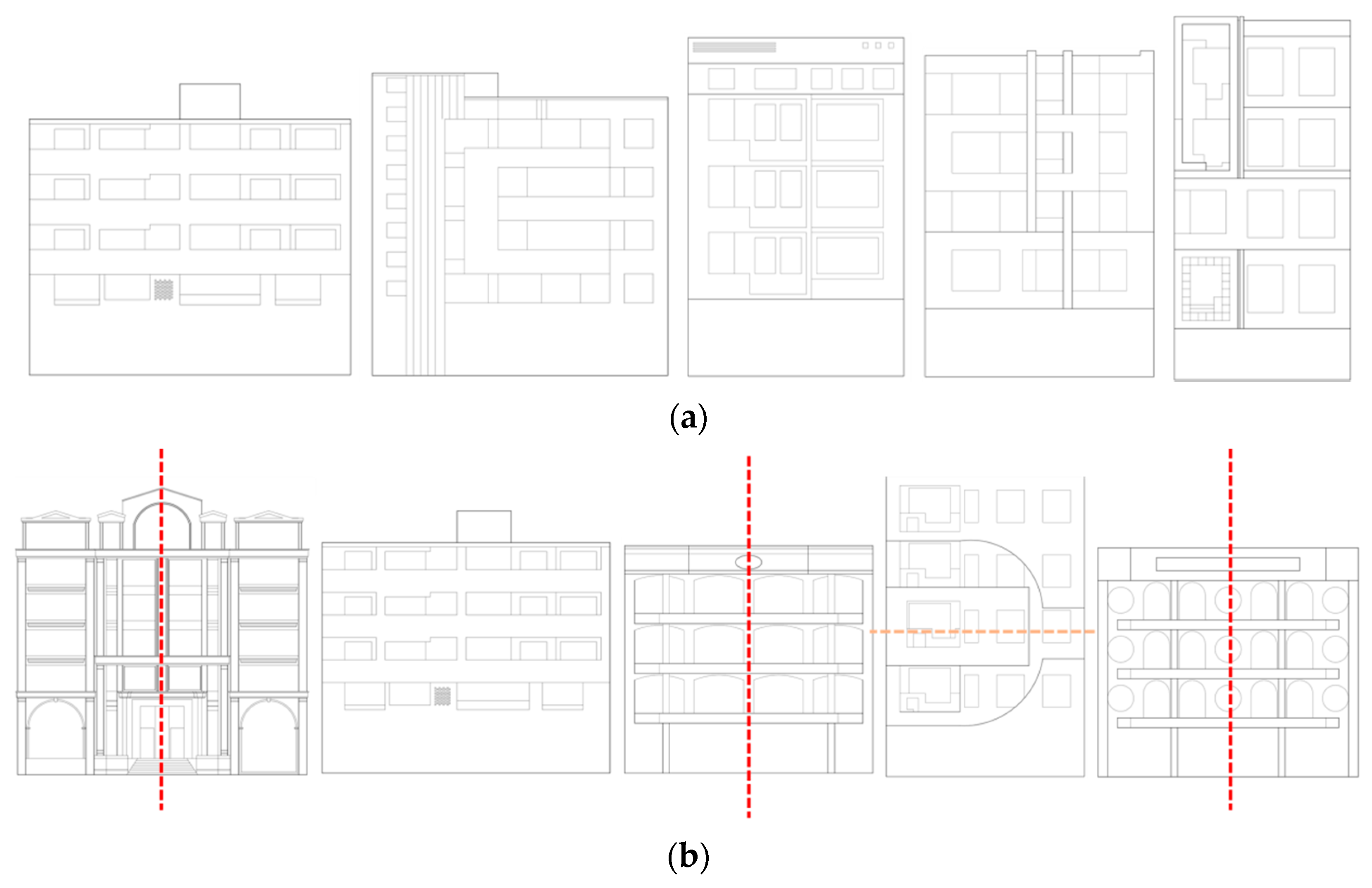
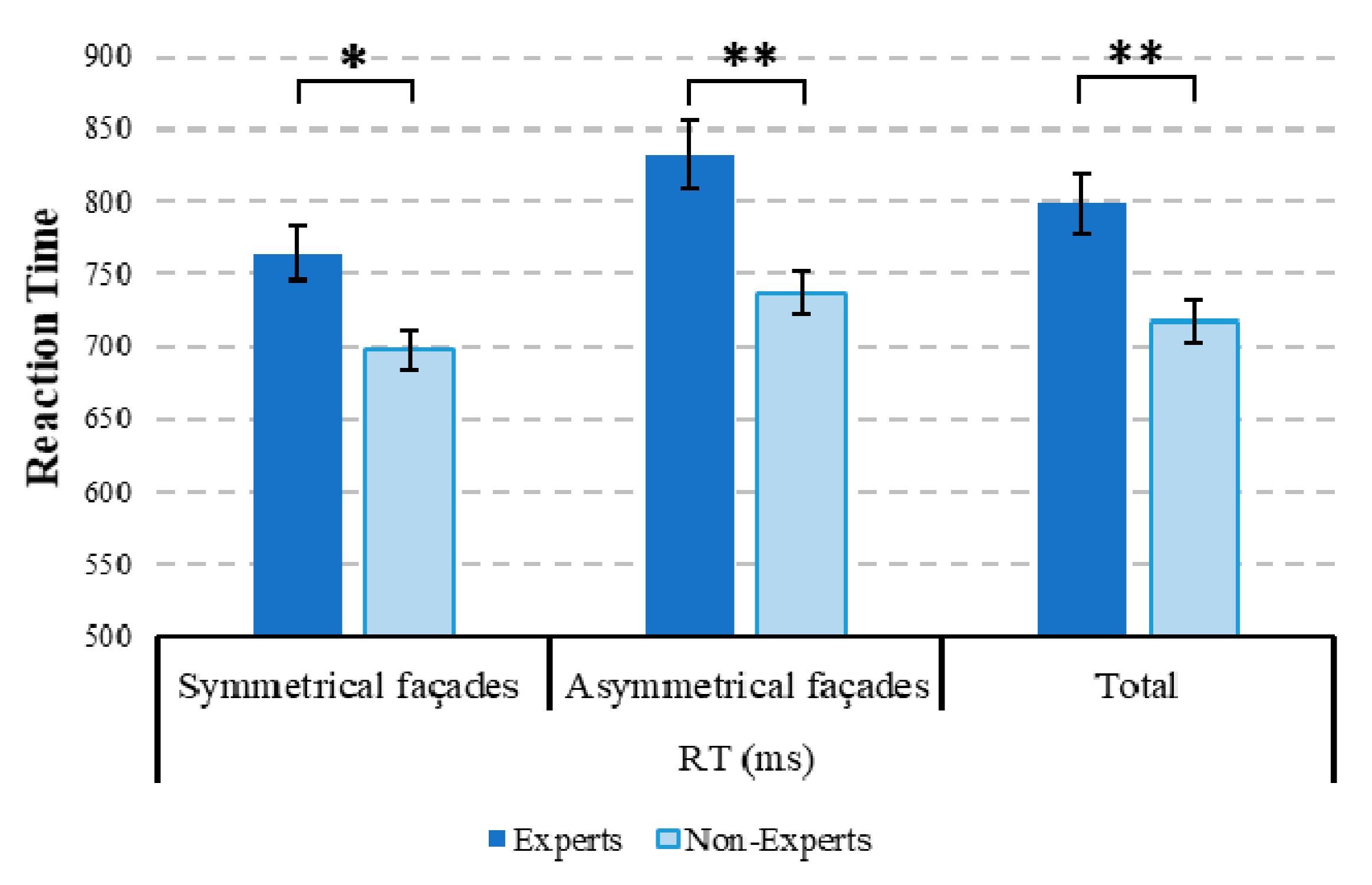
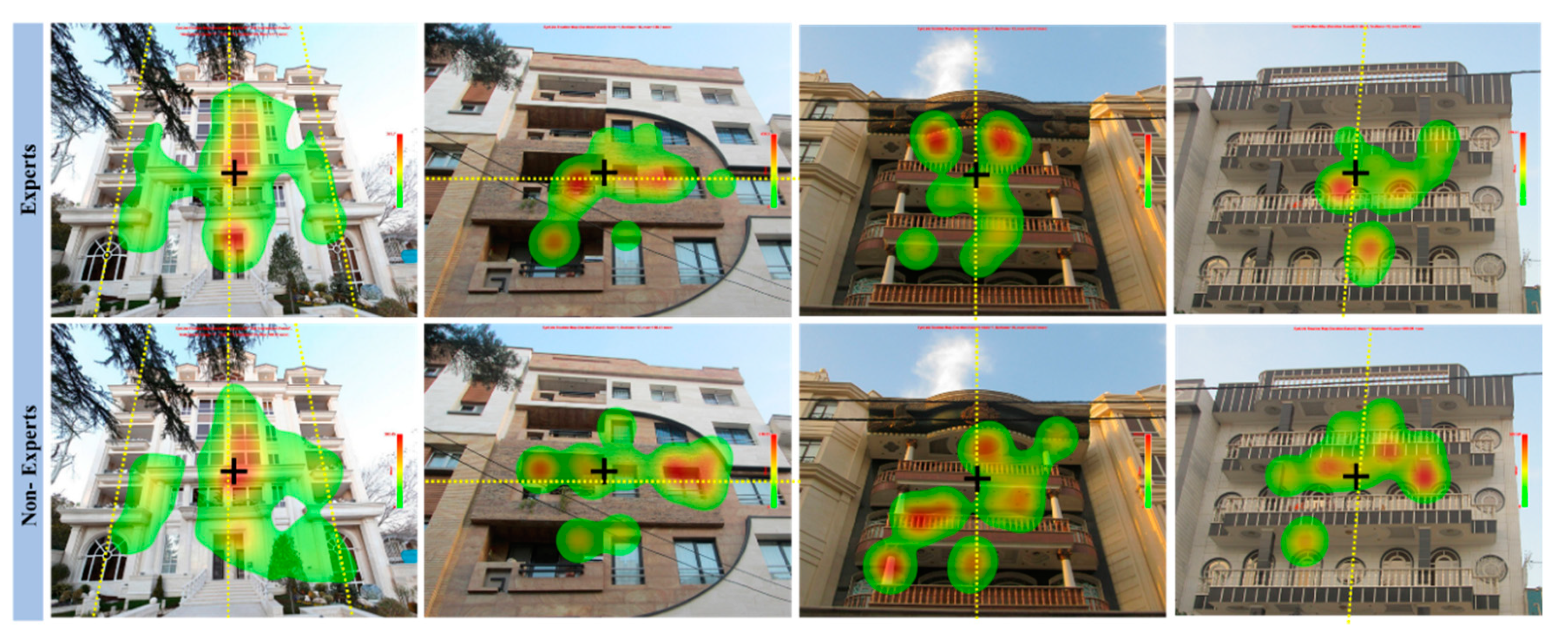
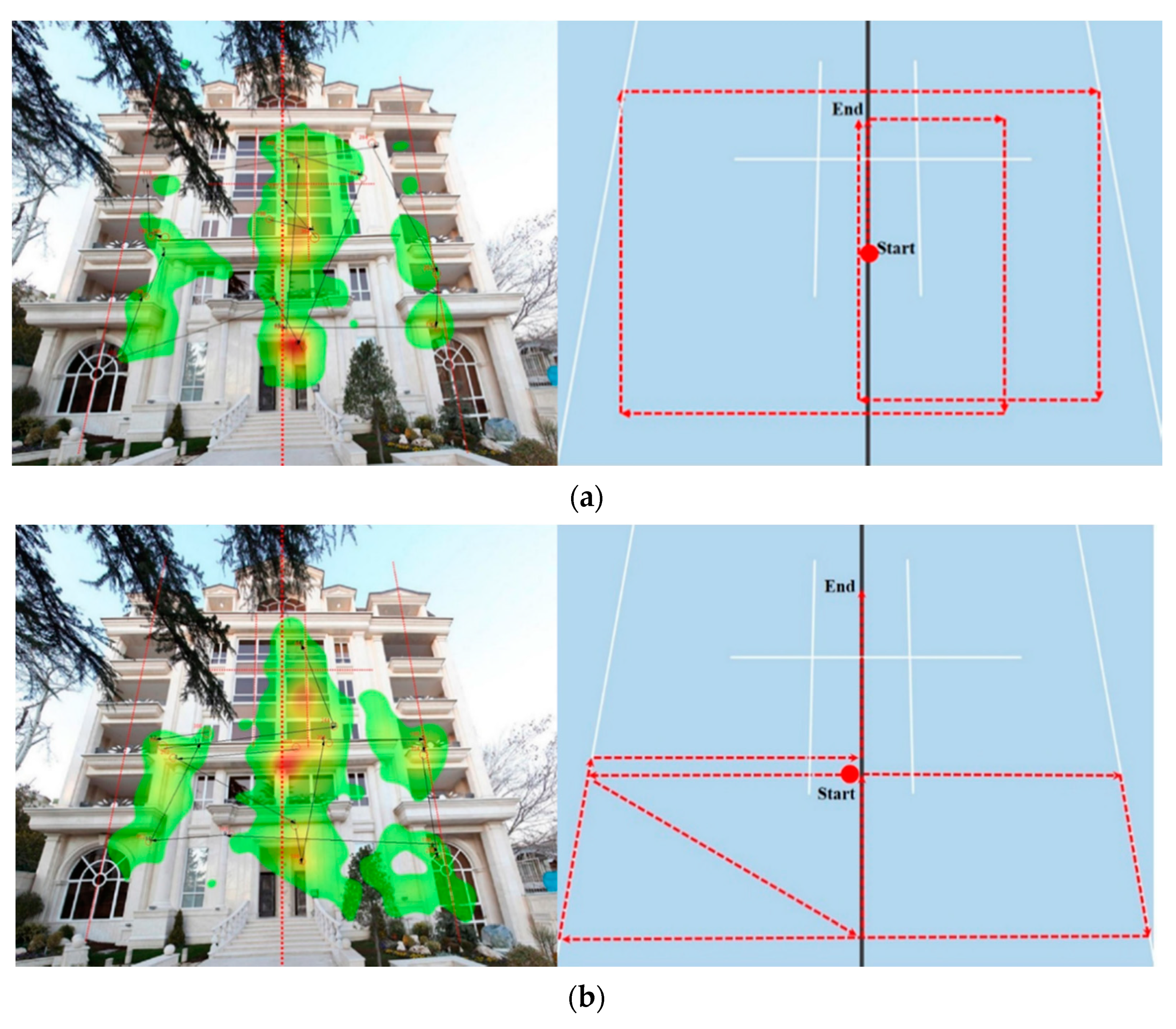
| Indicator | Description | Source |
|---|---|---|
| Fixation | • Shortstops pause in gaze position in specific positions. | [50] |
| Number of fixations | • Number of fixations on areas with information relevant. • Related to participant attention. | [51] [5] |
| Fixation duration | • Time of one fixation. • Usually associated with a difficult and intensive cognitive process. | [51] [52] |
| Saccade | • Quick eye movements as the gaze travels from one fixation point to another. | [53] |
| Saccade duration | • The time between the departure of fixation and doing another one. | [54] |
| Saccade amplitude | • The amplitude of the saccade in visual degrees. • The distance traveled by a saccade. | [54] |
| Scan path length | • Gaze positions and eye movements during observing the stimuli. • The scan path is a set of fixations in chronological order. | [53] [55] |
| Score | 0 | 1 | 2 | 3 | 4 | 5 | 6 | 7 | 8 | 9 |
| Aesthetic level | unpleasant | moderate | pleasant | |||||||
© 2020 by the authors. Licensee MDPI, Basel, Switzerland. This article is an open access article distributed under the terms and conditions of the Creative Commons Attribution (CC BY) license (http://creativecommons.org/licenses/by/4.0/).
Share and Cite
Azemati, H.; Jam, F.; Ghorbani, M.; Dehmer, M.; Ebrahimpour, R.; Ghanbaran, A.; Emmert-Streib, F. The Role of Symmetry in the Aesthetics of Residential Building Façades Using Cognitive Science Methods. Symmetry 2020, 12, 1438. https://doi.org/10.3390/sym12091438
Azemati H, Jam F, Ghorbani M, Dehmer M, Ebrahimpour R, Ghanbaran A, Emmert-Streib F. The Role of Symmetry in the Aesthetics of Residential Building Façades Using Cognitive Science Methods. Symmetry. 2020; 12(9):1438. https://doi.org/10.3390/sym12091438
Chicago/Turabian StyleAzemati, Hamidreza, Fatemeh Jam, Modjtaba Ghorbani, Matthias Dehmer, Reza Ebrahimpour, Abdolhamid Ghanbaran, and Frank Emmert-Streib. 2020. "The Role of Symmetry in the Aesthetics of Residential Building Façades Using Cognitive Science Methods" Symmetry 12, no. 9: 1438. https://doi.org/10.3390/sym12091438
APA StyleAzemati, H., Jam, F., Ghorbani, M., Dehmer, M., Ebrahimpour, R., Ghanbaran, A., & Emmert-Streib, F. (2020). The Role of Symmetry in the Aesthetics of Residential Building Façades Using Cognitive Science Methods. Symmetry, 12(9), 1438. https://doi.org/10.3390/sym12091438







